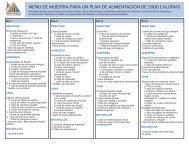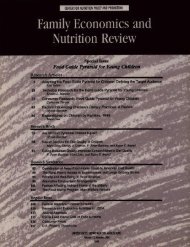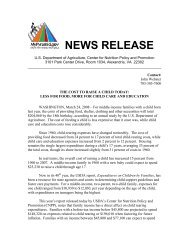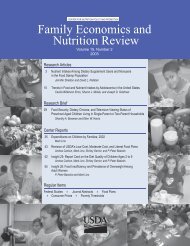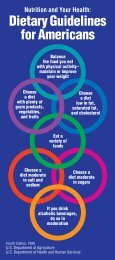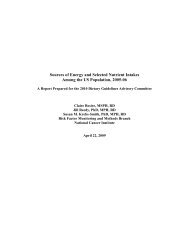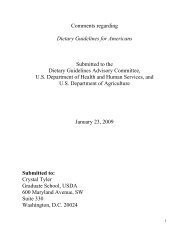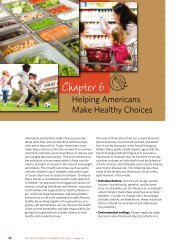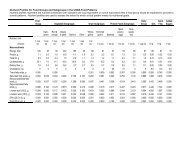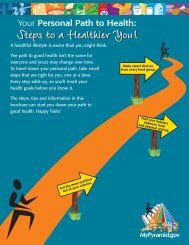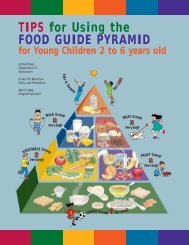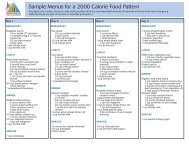Elderly Nutrition - Center for Nutrition Policy and Promotion - US ...
Elderly Nutrition - Center for Nutrition Policy and Promotion - US ...
Elderly Nutrition - Center for Nutrition Policy and Promotion - US ...
You also want an ePaper? Increase the reach of your titles
YUMPU automatically turns print PDFs into web optimized ePapers that Google loves.
Measuring the Food Security of<br />
<strong>Elderly</strong> Persons<br />
Mark Nord, PhD<br />
Economic Research Service<br />
U.S. Department of Agriculture<br />
This study assessed the appropriateness of the U.S. Food Security Scale <strong>for</strong><br />
measuring the food security of elderly persons <strong>and</strong>, in particular, whether<br />
measured prevalence rates of food insecurity <strong>and</strong> hunger among the elderly<br />
were likely to be biased, relative to those of the nonelderly. The findings, based<br />
on analysis of 3 years of data from the Current Population Survey Food Security<br />
Supplement, consistently indicated that the Food Security Scale fairly represented<br />
the food security status of elderly persons, compared with the food security status<br />
of nonelderly persons. Statistical analysis of the multiple-indicator scale found no<br />
indication that the scale underrepresented the prevalence of food insecurity or<br />
hunger among the elderly because they interpreted or responded to questions<br />
in the Food Security Scale differently than did the nonelderly. Responses to<br />
questions other than those in the scale indicated that some elderly did face<br />
food-access problems other than insufficient resources to buy food—most notably<br />
problems getting to a food store. However, these problems were no more likely<br />
<strong>for</strong> the elderly than <strong>for</strong> the nonelderly to be so serious that desired eating patterns<br />
were disrupted or food intake was insufficient. A small proportion of elderly<br />
households classified as food-secure obtained food assistance from Federal <strong>and</strong><br />
community programs, suggesting that some of these households were less than<br />
fully food-secure <strong>and</strong> that some may, indeed, be food-insecure. However, foodsecure<br />
elderly-only households were less likely than the food-secure nonelderly<br />
households to rely on food assistance programs that are accessible to both.<br />
E<br />
lderly persons are more foodsecure<br />
than are nonelderly<br />
persons, according to recent<br />
nationally representative food security<br />
surveys sponsored by the U.S. Department<br />
of Agriculture (<strong>US</strong>DA) (Nord,<br />
2002; Nord et al., 2002; Guthrie &<br />
Lin, 2002; Andrews, Nord, Bickel,<br />
& Carlson, 2000; Bickel, Carlson, &<br />
Nord, 1999). In these surveys, food<br />
security—defined as access at all times<br />
to enough food <strong>for</strong> an active, healthy<br />
life <strong>for</strong> all household members—is<br />
measured by a series of questions<br />
about behaviors <strong>and</strong> experiences<br />
known to characterize households that<br />
are having difficulty meeting their food<br />
needs (Fitchen, 1981; Fitchen, 1988;<br />
Radimer, Olson, & Campbell, 1990;<br />
Radimer, Olson, Green, Campbell &<br />
Habicht, 1992; Wehler, Scott, &<br />
Anderson, 1992). The U.S. Food<br />
Security Scale, calculated from responses<br />
to these questions, measures<br />
the food security of the household<br />
<strong>and</strong> classifies each as food-secure,<br />
food-insecure without hunger, or foodinsecure<br />
with hunger (Bickel, Nord,<br />
Price, Hamilton, & Cook, 2000; Hamilton<br />
et al., 1997a; 1997b). Concerns have<br />
been raised about whether this<br />
measurement method, based on selfreported<br />
food-access conditions <strong>and</strong><br />
behaviors, fairly represents the food<br />
security of elderly persons, compared<br />
with that of non-elderly persons. Food<br />
insecurity is known to be associated<br />
with poor nutrition <strong>and</strong> health<br />
2003 Vol. 15 No. 1 33



